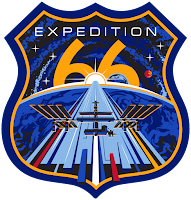ISS - Expedition 66 Mission patch.
March 3, 2022
Two NASA astronauts are assembling gear today they will install on the International Space Station during an upcoming spacewalk. The rest of the Expedition 66 crew focused on life science, space physics gear, and orbital maintenance.
NASA Flight Engineers Raja Chari and Kayla Barron began assembling modification kits today to ready the station’s truss structure for new roll-out solar arrays during the first spacewalk. The roll-out solar arrays will be delivered on an upcoming SpaceX Cargo Dragon mission and installed at a later date. The duo will set their U.S. spacesuits to battery power at 7:50 a.m. on March 15, signifying the beginning of their planned six-and-a-half-hour spacewalk. The second spacewalk on March 23 will see more roll-out solar array preparations by two yet to be named astronauts.
Image above: The waxing gibbous Moon is pictured on from the space station as it orbited above the Pacific Ocean off the coast of Canada. Image Credit: NASA.
Roll-out solar array technology will not only augment the space station’s existing solar arrays and power system, they will also be used to power the Lunar Gateway. Gateway is a space station developed by NASA, the Canadian Space Agency, ESA (European Space Agency), and the Japan Aerospace Exploration Agency that will orbit the Moon and will serve as a hub for crew visiting the lunar surface and beyond. Gateway will enable new scientific investigations in the cis-lunar environment during crewed and uncrewed periods.
As usual, science is always ongoing aboard the space station, both remotely and with astronaut participation, as crew members explored how microgravity affects human physiology on Thursday. NASA Flight Engineers Mark Vande Hei and Tom Marshburn partnered together in the Kibo laboratory module to study what happens to eye structure and visual function in weightlessness. Research operations were conducted inside the Life Science Glovebox and may provide insights and inform treatments for eye conditions in space and on Earth.
Astronaut Matthias Maurer of ESA (European Space Agency) collected his urine samples and stowed them in a science freezer for future analysis to understand how his body is adapting to the space environment. Maurer then moved on and replaced parts inside the Electromagnetic Levitator, a physics research facility that enables safe, high-temperature observations of the thermophysical properties of metallic alloys.
Animation Credits: ISS HD Live / Orbiter.ch Aerospace
Vande Hei reached 328 days in space today passing NASA astronaut Christina Koch’s record set back on Feb. 6, 2020. He will break NASA’s all-time single spaceflight record of 340 days on March 15 set by NASA astronaut Scott Kelly back on March 1, 2016. Vande Hei will return to Earth on March 30 having achieved a NASA record-breaking 355 days on orbit.
Commander Anton Shkaplerov of Roscosmos was on duty on Thursday replacing life support gear in the station’s Russian segment. Flight Engineer Pyotr Dubrov worked on computer and video gear then checked thermal hardware in the Nauka multipurpose laboratory module.
Related links:
Expedition 66: https://www.nasa.gov/mission_pages/station/expeditions/expedition66/index.html
Lunar Gateway: https://www.nasa.gov/gateway
Kibo laboratory module: https://www.nasa.gov/mission_pages/station/structure/elements/japan-kibo-laboratory
Eye structure and visual function: https://www.nasa.gov/mission_pages/station/research/experiments/explorer/Investigation.html?#id=7930
Life Science Glovebox: https://www.nasa.gov/mission_pages/station/research/experiments/explorer/Facility.html?#id=7676
Science freezer: https://www.nasa.gov/mission_pages/station/research/experiments/explorer/Facility.html?#id=56
Electromagnetic Levitator: https://www.nasa.gov/mission_pages/station/research/experiments/explorer/Facility.html?#id=1853
Nauka multipurpose laboratory module: https://www.roscosmos.ru/tag/nauka/
Space Station Research and Technology: https://www.nasa.gov/mission_pages/station/research/overview.html
International Space Station (ISS): https://www.nasa.gov/mission_pages/station/main/index.html
Image (mentioned), Animation (mentioned), Text, Credits: NASA/Mark Garcia.
Best regards, Orbiter.ch



